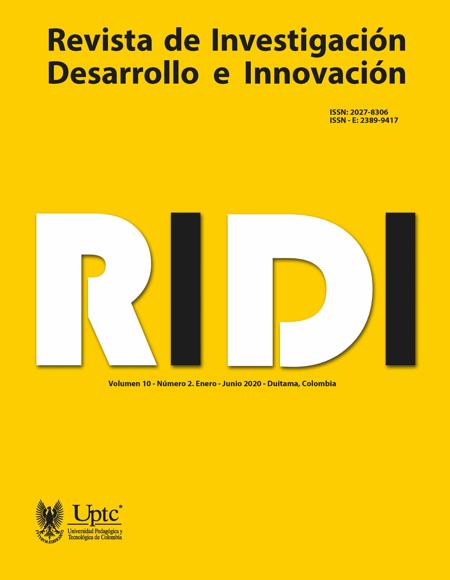Laboratory of social innovation: creative hybridization between the social needs and significant experiences of students of business administration
DOI:
https://doi.org/10.19053/20278306.v10.n2.2020.10518Keywords:
social innovation;, business ethics;, laboratories;, formation;, respect for lifeAbstract
A qualitative investigation was carried out in the Business Administration Program of the University of the Amazonia, with students from the last semester. The objective was the application of a laboratory of social innovation, in the course of business ethics, to promote creative hybridization between the social needs of the city of Florencia and the significant learning of students. The methodological design used was action research in which seventy students participated who were chosen through non-probabilistic sampling. The results obtained were the invention of different prototypes that the subjects created from the problem posed in the laboratory. Most of these artifacts symbolized strength or power as the main element to raise awareness about respect for life. It is recommended to continue developing these training strategies, to promote in future professionals of administrative knowledge, skills that solve not only business but social difficulties, reinforcing teamwork, creativity and the ability to innovate.
Downloads
References
Acevedo, S., & Dassen, N. (2016). Innovation for better management: The contribution of public innovation labs. Inter-American Development Bank. Recuperado de: https://publications.iadb.org/en/innovation-better-management-contribution-public-innovation-labs
Álvarez-Santullano, M. M., & Prada-Creo, E. (2018). Evaluación de las competencias profesionales a través de las prácticas externas: incidencia de la creatividad. Revista de Investigación Educativa, 36 (1), 203-219. doi: http://dx.doi.org/10.6018/rie.36.1.275651
Ávalos-Dávila. C., & Sevillano-García. M. L. (2018). El desarrollo de competencias investigativas en la formación de estudiantes de la UNED de Costa Rica mediante la metodología Lean Startup. Revista Educatio Siglo XXI, 36 (3), 417-442. doi: https://doi.org/10.6018/j/350071
Bautista, G., Borges, F., & Forés, A. (2006). Didáctica universitaria en entornos virtuales de enseñanza-aprendizaje. Madrid, España: Narcea.
Bordignon, F. R. A. (2017). Laboratorios de innovación ciudadana, espacios para el hacer digital crítico. Virtualidad, Educación y Ciencia, 14 (8). 165-181. Recuperado de http://sedici.unlp.edu.ar/bitstream/handle/10915/60952/Documento_completo__.pdf-PDFA.pdf?sequence=1&isAllowed=y
Brown, T. & Wyatt, J. (2010). Design Thinking for Social Innovation. Stanford Social Innovation Review. 12 (1). 29 – 43. doi: https://doi.org/10.1596/1020-797X_12_1_29
Brown, T. (2008). Design thinking. Harvard business review, 86 (6), 1-10. Recuperado de: https://fusesocial.ca/wp-content/uploads/sites/2/2018/06/Design-Thinking.pdf
Castro-Spila, J., Luna, A., & Unceta, A. (2016), “Social innovation regimes: an exploratory framework to measure social innovation”, SIMPACT Working Paper No. 1, Institute for Work and Technology, 1-24. Gelsenkirchen: Alemania.
Chávez, A. (2015). Socialización de las competencias profesionales en varones y mujeres y sus implicaciones. Electronic Journal of Research in Educational Psychology, 7 (21), 466-474.
Chesbrough, H. W. (2003). Open Innovation: The New Imperative for Creating and Profiting from Technology. Boston, USA: Harvard Business School Press
Clarke, R. V., & Eck, J. E. (2008). 60 pasos para ser un analista delictivo (1a. ed.). México: INACIPE.
Cohen, L., E., & Felson, M. (1979). Social Change and Crime Rate Trends: A Routine Activity Approach. American Sociological Review, 44 (4), 588-608. Recuperado de: www.jstor.org/stable/2094589
Cornish, D. B., & Clarke, R. V. (2008). The Rational Choice Perspective. Wortley, R., & Mazerolle, Y. Environmental Criminology and Crime Analysis. Portland, Oregón: Willan.
Cruz-Rojas, G., Molina-Blandón, M., & Valdiri-Vinasco, V. (2019). Vigilancia tecnológica para la innovación educativa en el uso de bases de datos y plataformas de gestión de aprendizaje en la universidad del Valle, Colombia. Revista de Investigación, Desarrollo e Innovación, 9 (2), 303-317. doi: https://doi.org/10.19053/20278306.v9.n2.2019.9175
Damanpour, F. & Gopalakrishnan, S. (2001): The dynamics of the adoption of product and process innovations in organizations. Journal of Management Studies. 38 (1). 45-65.
Fressoli, M., Arond, E., Abrol, D., Smith, A., Ely, A., & Días, R. (2014). When grassroots innovation movements encounter mainstream institutions: implications for models of inclusive innovation. Innovation and Development, 4 (2), 277-292. doi: https://doi.org/10.1080/2157930X.2014.921354
Galeano-Barrera, C., Bellón-Monsalve, D., Zabala-Vargas, S., Romero-Riaño, E., & Duro-Novoa, V. (2018). Identificación de los pilares que direccionan a una institución universitaria hacia un smart-campus. Revista de Investigación, Desarrollo e Innovación, 9 (1), 127-145. https://doi.org/10.19053/20278306.v9.n1.2018.8511
Guillen-Parra., M. (2006). Ética en las organizaciones: construyendo confianza. Pearson Prentice Hall.
Hassan, Z. (2014). The social labs revolution: A new approach to solving our most complex challenges. San Francisco, CA, USA: Berrett-Koehler.
Hernández-Sampieri., R. Fernández-Collado., C. & Baptista-Lucio., P. (2015). Metodología de la Investigación. México D.F.: McGraw Hill.
Hillgren, P. A., Seravalli, A., & Emilson, A. (2011). Prototyping and infrastructuring in design for social innovation. CoDesign, 7 (3-4), 169-183. doi: https://doi.org/10.1080/15710882.2011.630474
Jurado-Paz, I., & Morán-Vallejo, M. (2019). Gestión universitaria de la innovación social promovida desde espacios académicos relacionados con el emprendimiento, la investigación y la proyección social. Revista de Investigación, Desarrollo e Innovación, 9 (2), 261-272. https://doi.org/10.19053/20278306.v9.n2.2019.9161
Marina, J. A. (2010). La competencia de emprender. Revista de Educación, 351, 49-71. Recuperado de: https://goo.gl/qfrbaJ
Mercado-Martínez, F. J. (2002). Investigación cualitativa en América Latina: Perspectivas críticas en salud. International Journal of Qualitative Methods, 1 (1), 1-27. Recuperado de: https://sites.ualberta.ca/~iiqm/backissues/1_1Final/pdf/mercadospanish.pdf
Oseda-Gago, D., Mendivel-Geronimo, R. K., Oliva-Paredes, R., Vargas-Flores, J. I., & Patiño-Rivera, A. R. (2019). Autoeficacia Emprendedora y Capacidad Creativa en la Universidad Nacional Intercultural de la Amazonia. Repositorio de Revistas de la Universidad Privada de Pucallpa, 3 (03), 6-11. Recuperado de: http://revistas.upp.edu.pe/index.php/RICCVA/article/view/114
Osorio-Atehortúa, U. A., & Malavera-Pineda, S. M. (2018). Medios digitales emergentes en la implementación de didácticas específicas en el programa de administración de empresas. Prisma Social: revista de investigación social, (21), 438-457. Recuperado de: https://dialnet.unirioja.es/servlet/articulo?codigo=6521446
Pacheco-Zerga, L. (2007). El “derecho de morir” y el “deber de matar” por respeto a la dignidad humana. Revista de Derecho Universidad de Piura. 8 (8). 45-60. Recuperado de: https://pirhua.udep.edu.pe/handle/11042/2623
Rheingold, H. (2014). The Peeragogy Handbook. A guide for Peer-Learning and Peer Production, 2. Arlington, Estados Unidos: MA Peirce Press.
Roig-Vila, R. (2017). Investigación en docencia universitaria. Diseñando el futuro a partir de la innovación educativa. Ediciones Octaedro, S.L. Barcelona, España.
Romero-Haddad, C. M., & De la Puente, K. I. (2019). Diagnóstico sobre la Prospectiva de Generación de Empresas y Proyectos Productivos de Emprendimiento Social y Economías Creativas en el Sector Solidario, Propuestos por Estudiantes de la UCC Sede Montería año 2017. Crescendo, 10 (1), 241 - 261. doi: https://doi.org/10.21895/incres.2019.v10n1.14
Scales, P.C., & Leffert, N. (1999). Developmental assets: A synthesis of the scientific research on adolescent development. Minneapolis, MN: Search Institute.
Silveira-Gorski. H. C. (2000). La vida en común en sociedades multiculturales. Aportaciones para un debate. Identidades comunitárias y democracia, 11-46. Madrid, España: Trotta.
Steinbeck, R. (2011). "Building Creative Competence in Globally Distributed Courses through Design Thinking", Comunicar, 37 (19). 27-35. Recuperado de: http://eprints.rclis.org/16746/1/en27-35.pdf
The Rockefeller Foundation. (2014). “Social Innovation Labs. How Social Innovation Labs Can Advance your Work.” Recuperado de: http://globalknowledgeinitiative.org/pdf/SocialInnovation-Labs-External-Guide.pdf
Transparencia Internacional. (2018). Índice de Percepción de Corrupción (IPC). Recuperado de: http://transparenciacolombia.org.co/informe-anual-2018/
Vozmediano-Sanz, L., & San Juan-Guillén, C. (2010). Criminología ambiental. Ecología del delito y de la seguridad, (1a ed.). España: Editorial UOC.
Downloads
Published
How to Cite
Issue
Section
License
Published articles in this journal are protected by a licence Creative Commons Attribution 4.0 International License. The content of articles is responsibility of each author and do not involve to the journal or the institution. It is allowed the diffusion and reproduction of titles, abstracts, and total content with academic, scientific, cultural, and/or commercial purposes, as long as it gives credit to the respective source.











